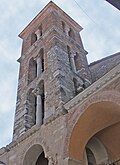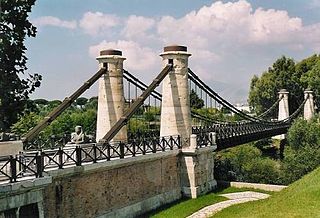Loading AI tools
Comune in Lazio, Italy From Wikipedia, the free encyclopedia
Minturno is a city and comune in southern Lazio, Italy, situated on the north west bank of the Garigliano (known in antiquity as the Liris).
Minturno | |
|---|---|
 View of Minturno Cathedral | |
| Coordinates: 41°16′N 13°45′E | |
| Country | Italy |
| Region | Lazio |
| Province | Latina (LT) |
| Area | |
| • Total | 42 km2 (16 sq mi) |
| Population (2018-01-01)[2] | |
| • Total | 19,804 |
| • Density | 470/km2 (1,200/sq mi) |
| Time zone | UTC+1 (CET) |
| • Summer (DST) | UTC+2 (CEST) |
| Patron saint | Madonna delle Grazie |
| Saint day | September 1 |
| Website | Official website |
This section needs additional citations for verification. (March 2024) |

The nearby sanctuary of Marica with an Italic tuff temple was built about 500 BC.
Ancient Minturnae was one of the three towns of the Ausones which made war against Rome in 314 BC, in the Second Samnite War, the other two being Ausona (modern Sessa Aurunca) and Vescia.[3] It became a Roman settlement as a fort (Castrum Minturnae) in about 296 BC. The early town grew around the square fort with polygonal stone walls on the side of the river and on the contemporary via Appia as a military road. In the 3rd century BC, the town expanded with new tufa walls with towers.
The city was radically transformed when it became a colonia under Augustus when the urban tract of the via Appia was enhanced with porticos, temples to Augustus and Julius Caesar were built and the theatre was rebuilt. [4]
The city was further expanded under Hadrian with thermal baths, the macellum, nymphaeum and aqueduct. It was destroyed by the Langobards in 590. The city was probably also destroyed in 883 by the Saracens, who in the following years held the surrounding plain. Its low site was increasingly abandoned by the population in favour of that of the modern town of Minturno (known as Traetto or Traietto, from Latin Traiectum, until the 19th century), 140 metres (460 ft) above sea-level.
The Saracens were ousted by the Catholic league after the Battle of Garigliano (915), and Minturnae passed to Gaeta. Two years later, however, it was again ravaged, this time by the Magyars. In 1058, it was partly acquired by the Abbey of Montecassino, but soon after was conquered by the Normans.
In the 13th century, it went to Richard V dell'Aquila, duke of Gaeta. Subsequently, it was a Caetani possession, and later assigned by Charles VIII of France to his general Prospero Colonna. It was a Carafa fief until 1806, and was integrated in the newly formed Kingdom of Italy on 30 October 1861.
Minturno was part of the Gustav Line during World War II, and suffered heavy bombing.





Many of the main momumental buildings of the ancient city are visible at their site outside the modern city. The impressive Roman remains mainly date to the Hadrianic period (built over earlier buildings) and consist of the:
Close to the mouth of the river, about 2 km distant, was the sacred grove of the Italic goddess Marica.


The engineer who designed the bridge was Luigi Giura. The bridge has been rebuilt in recent time (1998), in fact was mined during the Second World War.

The suburb of Scauri, on the Gulf of Gaeta, may take its name from the Roman consul Marcus Aemilius Scaurus, who had a sumptuous villa here. It has some notable ancient watchtowers, including the Torre Saracena, at the mouth of the river Garigliano, erected between 961 and 981, commemorates a victory gained by Pope John X and his allies over the Saracens in 915 (see battle of Garigliano). It is built of Roman materials from Minturnae, including several inscriptions and sculptures.
In the early 20th century, many residents of Minturno and the villages around it emigrated to Stamford, Connecticut, in the United States. A club for Minturnese immigrants, the Minturno Social Club was founded in the West Side of Stamford in 1939 (and has since moved to the Springdale district) and only made up of members whose families hailed from Minturno, had 120 members in 2007. A Minturnese tradition, the Festa de la Regna ("Festival of Wheat") celebration of harvest day and honoring the Madonna delle Grazie, is still honored in Stamford with an annual procession.[7]
Michael Fedele, former lieutenant governor of Connecticut, was born in Minturno in 1955.
Seamless Wikipedia browsing. On steroids.
Every time you click a link to Wikipedia, Wiktionary or Wikiquote in your browser's search results, it will show the modern Wikiwand interface.
Wikiwand extension is a five stars, simple, with minimum permission required to keep your browsing private, safe and transparent.